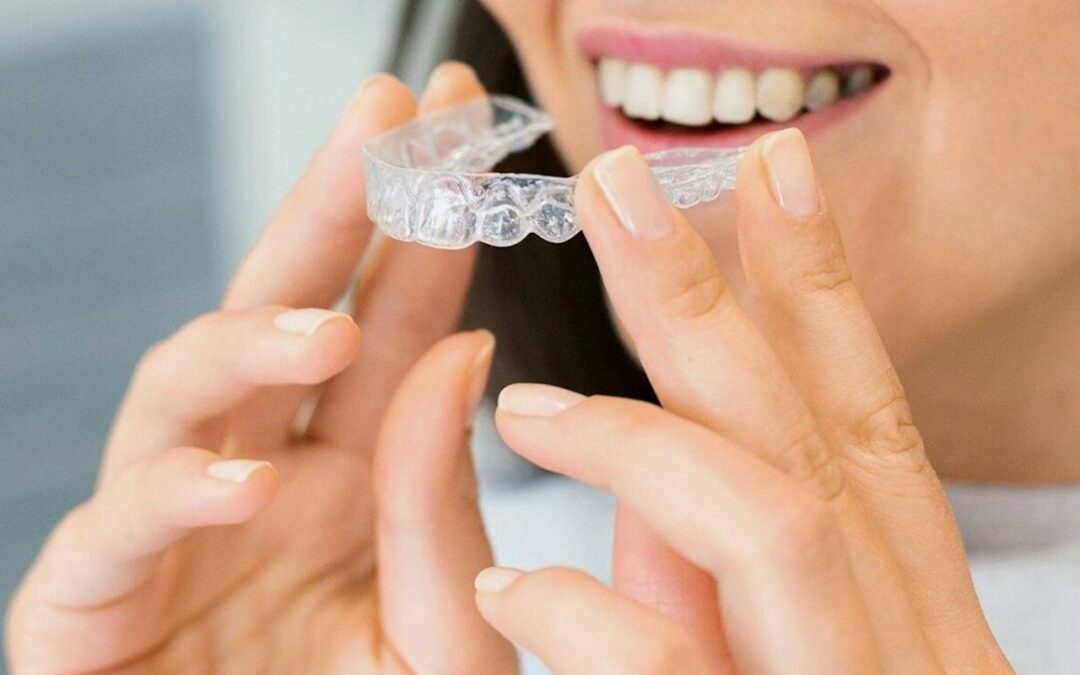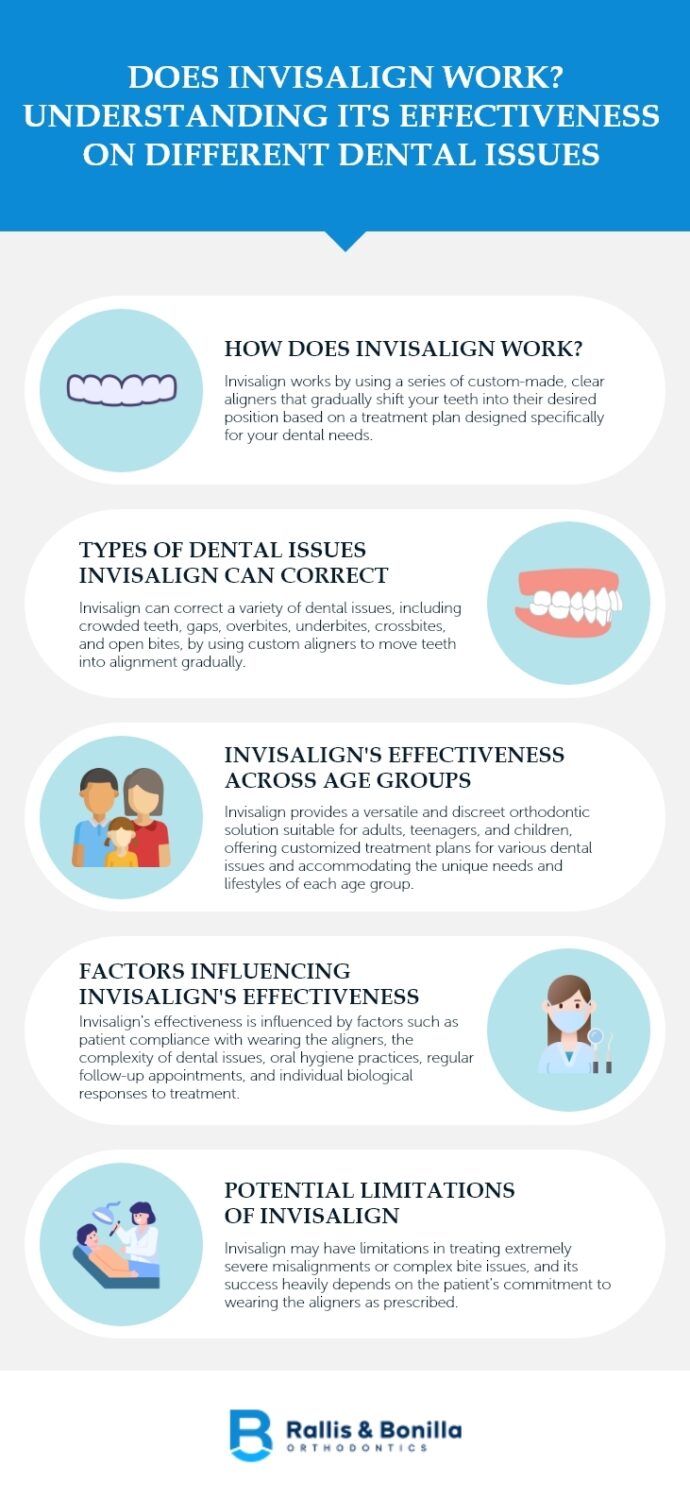Invisalign is an innovative orthodontic treatment that has become increasingly popular as a discreet and convenient alternative to traditional braces. Using a series of clear, removable aligners, Invisalign helps correct a majority of mild to moderate dental issues without the conspicuousness of metal wires and brackets. If you’ve been considering orthodontic treatment but are looking for a less noticeable, more comfortable option, Invisalign might be the perfect fit. This post will delve into how Invisalign works, its effectiveness on various dental issues, and factors that influence its effectiveness. Whether you’re considering Invisalign for yourself or simply curious about its capabilities, our aim is to provide you with clear, comprehensive information to help you make an informed decision. Join us as we uncover the potential of Invisalign to transform your smile.
How Does Invisalign Work?
Invisalign transforms smiles through a series of clear, custom-made aligners designed to shift your teeth into their ideal position gently. During your initial consultation at Rallis and Bonilla Orthodontics, we will examine your teeth and bite to determine if Invisalign is suitable for your situation.
If Invisalign is deemed appropriate for you, we will take precise digital scans of your teeth. These scans are then used to create a 3D model of your mouth, allowing your orthodontist to plan out your entire treatment step by step, from the initial position of your teeth to their final desired placement.
Using this customized plan, a series of aligners are produced, each slightly different from the one before. These aligner trays are made of smooth, BPA-free plastic that is custom-fitted to your teeth. You’ll wear each plastic aligner for a week before moving on to the next in the series. Each set of aligners applies gentle pressure to your teeth, gradually guiding them into the desired position.
The beauty of Invisalign lies in its subtlety and efficiency. The aligners gently coax your teeth into place based on the precise movements your orthodontist has planned out for you. This process is not only effective for a wide range of orthodontic issues but also offers the convenience of being removable. This means you can take them out to eat, brush, and floss, making the journey to a beautiful smile as seamless and unintrusive as possible.
Throughout the treatment process, you’ll have periodic check-ups with us to track your progress and receive a new series of plastic aligners. These check-ups allow us to ensure that your treatment is going as planned and to make any necessary adjustments if required.
Types of Dental Issues Invisalign Can Correct
Invisalign is a versatile dental treatment capable of addressing a wide range of orthodontic issues, making it a popular choice for many seeking a straighter smile. Here are some of the dental concerns that Invisalign can effectively correct:
- Crowded Teeth – When there isn’t enough space in your jaw for all of your teeth to fit normally, they can overlap and twist. Invisalign aligners gently guide these teeth into proper positions, creating a neater appearance and improving oral health and hygiene.
- Gaps Between Teeth – Some people have extra space between their teeth, which can be a cosmetic concern or lead to gum problems. Invisalign works to evenly space out the teeth, closing any unwanted gaps.
- Overbites – An overbite occurs when the upper teeth bite too far over the lower teeth. This can cause wear on the lower teeth and even jaw pain. Invisalign aligners can adjust the alignment of the teeth and correct overbites.
- Underbites – An underbite is when the lower teeth protrude past the front upper teeth. It can make chewing and speaking clearly more difficult. Invisalign can help by moving the lower teeth back into the correct position.
- Crossbites – A crossbite occurs when some of the upper teeth bite inside the lower teeth instead of outside. This can lead to wear of the teeth, gum disease, and bone loss. Invisalign aligners can correct crossbite by realigning the affected teeth.
- Open Bites – An open bite is when the upper and lower teeth don’t touch when the mouth is closed. This issue can affect eating and speech. Invisalign can bring the teeth into proper contact, improving function and appearance.
Invisalign’s clear aligners offer a discreet and effective way to correct these issues, tailored specifically to each individual’s needs. Whether you’re looking to improve your smile’s appearance or address specific dental concerns, Invisalign provides a modern solution to help you achieve your goals.
Invisalign’s Effectiveness Across Age Groups
Invisalign offers a flexible and discreet solution for improving dental alignment across various age groups. Its effectiveness among different populations—adults, teenagers, and children—demonstrates its versatility and appeal. Here’s how Invisalign serves each group:
- Adults – Invisalign is highly effective for adults, especially those with mild to moderate orthodontic issues. Many adults prefer it over traditional braces due to its discreet appearance and removable nature. Invisalign aligners are virtually invisible and can be removed for important meetings or social events, making them a convenient choice for the adult lifestyle.
- Teenagers – Invisalign Teen is designed with the unique needs of teenagers in mind. These aligners include compliance indicators to ensure they are worn for the recommended amount of time and feature design accommodations for growing mouths. Teens appreciate Invisalign for its minimal impact on their appearance and the freedom it offers compared to traditional braces, allowing them to smile confidently throughout their treatment.
- Children – For younger children between the ages of six and ten with early orthodontic concerns, Invisalign First can address issues related to developing jaws and emerging teeth. This early intervention helps to guide growth and development, potentially reducing the need for more extensive orthodontic treatments later on. Invisalign for children is customized to be comfortable and adaptable to their active lives, encouraging positive oral health habits from a young age.
Across all age groups, Invisalign’s effectiveness is enhanced by its innovative design and personalized treatment plans, which are meticulously crafted to meet the individual’s dental and lifestyle needs.
Factors Influencing Invisalign’s Effectiveness
Invisalign’s ability to transform smiles hinges on several key factors. Understanding these can help set realistic expectations and contribute to the success of your treatment. Here’s what influences Invisalign’s effectiveness:
- Complexity of Dental Issues – Invisalign can address a wide range of dental problems, from simple to moderately complex cases. However, the nature and severity of your dental issues can affect how effectively Invisalign works for you. While Invisalign is adept at correcting issues like overcrowded teeth, gaps, and certain bite problems, extremely complex cases might require additional or alternative orthodontic strategies.
- Patient Compliance – One of the most critical factors is how diligently you follow your orthodontist’s instructions. Wearing your aligners for the recommended 20-22 hours per day, only removing them to eat, drink anything other than water, and for oral hygiene directly impacts your treatment’s success.
- Age and Bone Density – Though Invisalign is effective for all ages, younger patients may see quicker results due to the flexibility of their developing bone structure. For adults, treatment might take a bit longer but is still highly effective.
- Oral Hygiene and Care – Maintaining a good oral hygiene routine is paramount during Invisalign treatment. Properly cleaning your aligners and keeping your teeth and gums healthy ensures a smoother process and reduces the risk of complications.
- Regular Follow-ups – Attending scheduled appointments with your orthodontist allows for monitoring progress and making any necessary adjustments to your treatment plan. These check-ins are vital to staying on track toward achieving your desired results.
- Lifestyle Considerations – Your lifestyle choices, such as diet, smoking, and oral habits, can influence the effectiveness of Invisalign. For instance, smoking can stain aligners, and not using a protective case can lead to lost or damaged aligners, both of which can hinder progress.
Remember, the journey to a perfect smile is a partnership between you and your orthodontist, rooted in commitment and guided by professional expertise. With the right approach, Invisalign offers a clear path to achieving the confident, beautiful smile you’ve always desired.
Potential Limitations of Invisalign
While Invisalign offers a convenient and less visible alternative to traditional metal braces, it’s important to understand that certain situations might present challenges to its effectiveness. Here are some potential limitations of Invisalign to consider:
- Severe Misalignments and Bite Issues – Invisalign is incredibly effective for a wide range of dental issues, but extremely severe misalignments or complex bite issues may require more traditional orthodontic approaches. These might include cases that necessitate significant tooth movement or the use of specialized orthodontic appliances.
- Requires Discipline – Success with Invisalign heavily depends on your commitment to keep the aligners in for the recommended 20-22 hours daily. Unlike traditional braces, which are permanently affixed to the teeth, Invisalign’s removability requires a high degree of discipline to ensure effective treatment.
- Oral Habits – When you clench or grind your teeth, for example, you run the risk of damaging the aligners. Similarly, neglecting to store aligners properly when not in use can lead to loss or damage, affecting treatment duration.
- Treatment Duration Variability – While Invisalign typically offers a shorter treatment time compared to traditional braces for many cases, the exact duration can vary widely among individuals. Factors influencing treatment time include the complexity of the dental issues being addressed and how well the treatment plan is followed.
- Adjustments to Lifestyle – You must remove your aligners before eating or drinking anything other than water, which can be a slight inconvenience. Additionally, maintaining excellent oral hygiene is crucial, as failing to clean your aligners properly can lead to other dental issues.
- Speech Impediments – Some wearers might experience temporary speech changes, especially during the initial adjustment period. However, this usually improves as you get used to wearing the aligners.
- Discomfort – Like with any orthodontic treatment, you may experience some discomfort or soreness when starting a new set of aligners or during adjustments. However, this typically goes away within a few days as the teeth adjust to the aligners.
Understanding these limitations helps set realistic expectations for your Invisalign treatment. However, for many people, the benefits far outweigh the challenges. If you’re considering Invisalign, a detailed consultation with our orthodontist can provide clarity on how well it suits your specific needs and lifestyle.
Embark on your journey to a confident smile with Rallis and Bonilla Orthodontics, where we combine expertise with compassion to tailor a treatment plan that’s just right for you. Whether you’re considering Invisalign or seeking advice on the best orthodontic approach, our team is dedicated to providing you with a comfortable, personalized experience from start to finish. We believe everyone deserves a smile they’re proud to share, and we’re here to guide you every step of the way. Visit us at our North Star Office, 84th Street Office, or Yankee Hill Office to learn more about how we can transform your smile and boost your confidence.

